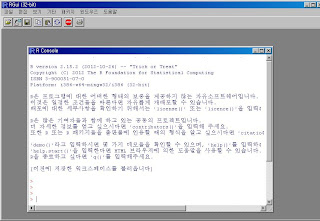It's been a long time since I posted. Actually I tried to make at least 2 new posts every week. I thought that was easy, however I think I am getting lazy.
Anyway, today I'll talk about "DATA Frame"
Data Frame is a columnar organization of data which is composed of named vectors, matrix or other data frame. (In fact, I don't mention other data objects that I didn't mention)
Let's make a DATA Frame with different ways
> Student <- c("Minseo","DK","KyungHwa")
> Math_Score <- c(80,90,60)
> Eng_Score <- c(80,60,70)
> Test_Result <- cbind(Student,Math_Score,Eng_Score)
[ Type A ]
> Test_Result_DF <- data.frame(Student, Math_Score, Eng_Score)
> Test_Result_DF
Student Math_Score Eng_Score
1 Minseo 80 80
2 DK 90 60
3 KyungHwa 60 70
[ Type B ]
> Test_Result_DF2 = as.data.frame(Test_Result)
> Test_Result_DF2
Student Math_Score Eng_Score
1 Minseo 80 80
2 DK 90 60
3 KyungHwa 60 70
As you can see, two different ways brought the same result.
Once you get a data frame, you can get a diverse results, if you want to get a result that mathematics score is above 70
> Test_Result_DF[Math_Score>70,]
Student Math_Score Eng_Score
1 Minseo 80 80
2 DK 90 60
Furthermore, you can choose the column.
> Test_Result_DF[Math_Score>70,1]
[1] Minseo DK
Levels: DK KyungHwa Minseo
> Test_Result_DF[Math_Score>70,c(1,2)]
Student Math_Score
1 Minseo 80
2 DK 90
> Test_Result_DF[Math_Score>70,c(1,2,3)]
Student Math_Score Eng_Score
1 Minseo 80 80
2 DK 90 60
I already said, data frame is a columnar organization of data which is composed of named vectors, matrix or other data frame. Therefore you can add data frame into another data frame.
> data.frame(Student, Math_Score2=Math_Score, Eng_Score2=Eng_Score)
Student Math_Score2 Eng_Score2
1 Minseo 80 80
2 DK 90 60
3 KyungHwa 60 70
> Test_Result_DF3 <- data.frame(Student, Math_Score2=Math_Score, Eng_Score2=Eng_Score)
> merge(Test_Result_DF, Test_Result_DF3)
Student Math_Score Eng_Score Math_Score2 Eng_Score2
1 DK 90 60 90 60
2 KyungHwa 60 70 60 70
3 Minseo 80 80 80 80
>
Data frame also gives useful functions.
> Test_Result_DF[1,]
Student Math_Score Eng_Score
1 Minseo 80 80
> Test_Result_DF[2,]
Student Math_Score Eng_Score
2 DK 90 60
> Test_Result_DF[2,2]
[1] 90
> Test_Result_DF[2,3]
[1] 60
> Test_Result_DF[,3]
[1] 80 60 70
head (Test_Result_DF, 2)
Student Math_Score Eng_Score
1 Minseo 80 80
2 DK 90 60
I think Data Frame is very useful.
See you next time.

